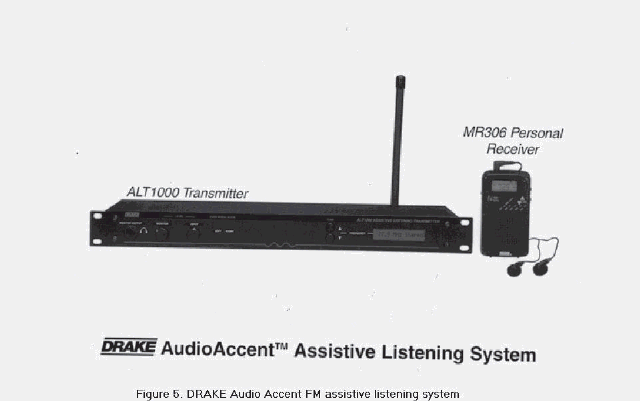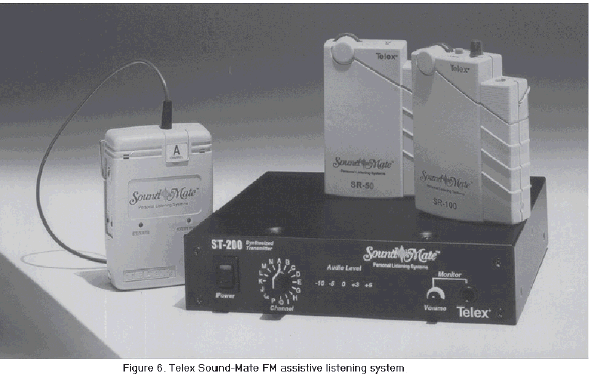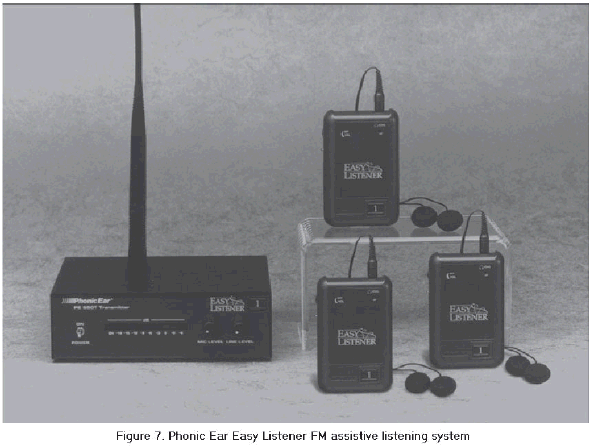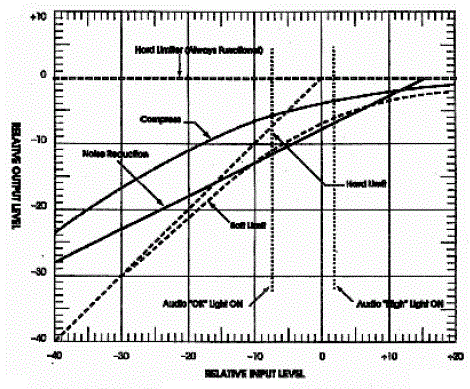2.2 FM Radio Systems
2.2.1 General Description
There are two types of FM listening systems. One is a personal system, designed to be used by an individual on a one-to-one basis (Yuzon l994). The other, the type that concerns us in this paper, is meant to service one or more listeners in such large-area listening venues as auditoriums, classrooms, all types of theaters, and houses of worship (Ross l994). Both types are basically FM radios where the audio signal is "broadcast" to listeners wearing FM receivers tuned to the transmitting frequency. ALS can be a "standalone" device, or be integrated into an existing Public Address (PA) system (Compton l991). Of the three types of ALS described in this document, FM radio systems appear the easiest to install; generally, all that is required is a patch cord between an output from the PA amplifier ("line-out" or other audio output) and the input to the FM transmitter. Transmitters range in complexity from simple devices that include only basic interconnection and transmission capacities, to sophisticated devices that are capable of accepting a range of inputs from different sources and that incorporate many signal processing options (such as high frequency pre-emphasis, various compression options, etc.). Examples of commercially available large-area FM systems are displayed in figures 5, 6, 7, and 8.




2.2.2 Standards
2.2.2.1 FCC Regulations
In 1982, the Federal Communications Commission authorized the use of frequencies within the 72‒76 MHz band as the designated radio frequencies that could be used by people with hearing loss. This is non-exclusive, unlicenced band. Other users, such as pagers, emergency vehicles, etc. are also permitted to transmit radio signals on frequencies within this band. ALS manufacturers differ in how they allocate this band. For example: Phonic Ear makes 40 narrow-band (50 kHz) channels available; Gentner uses 37 narrow-band (50 kHz) channels; Telex, 16 narrow-band (50 kHz) channels; Drake, 10 wider (150 kHz) channels; Williams, 10 wide (200 kHz) or 40 narrow-band (50 kHz) channels, while Comtek employs 10 wide-bands (200 kHz) and narrow-band (50 kHz) channels both in the 72‒76 MHZ and in the 216 to 217 MHZ bands. Some of the frequencies used by different manufacturers may be identical, while others may differ. The FCC also permits the use of the 216‒217 MHz band as a low power radio source for auditory assist ive devices and several manufacturers are now marketing large area transmitter using this higher frequency band. ALS in really large venues, such as football stadiums, can also employ one of the commercial FM frequencies as long as they meet the power requirements designated by the FCC.
In terms of the permitted maximum power of ALS, the FCC limits it to no more than 80 millivolts per meter at 3 meters. This can provide for an effective transmission range between 300 and 500 feet. Larger antennas can extend this range to l000 feet; however, the maximum strength cannot be exceeded regardless of antenna design. The 216‒217 MHz band does permit higher signal strength and can provide greater operating distances. Within the transmission range, the field-strength of the transmitted radio signal should be adequate and equal at all seat locations within a venue. ALS are "low-power" devices that are not likely to interfere with other permitted user in the same channels (i.e. paging devices, emergency vehicles). No priority is given assistive listening devices. When interference occurs from other radio sources, the onus is on the ALS user to switch to another channel within the same frequency band.
2.2.2.2 New York State Standards
As far as can be determined, New York is the only state that has developed written standards for large area FM assistive listening systems. Enforcement of the standards is the option of the local building code inspectors (who have, literally, thousands of items to verify on a checklist code). Information and educational sessions can help ensure their understanding and compliance with the ALS standards (Johnstone l997). The New York State standards reflect the combined operation of both the transmitter and the receiver using various coupling options.
* Given an appropriate input signal to the transmitter (as specified by the transmitter's specifications), the frequency response at the output of the receiver and transducer should not vary more than +/- 5 dB over the frequency range 100 to 8000 Hz from the value at 1000 Hz. (Note: This appears to be an overstatement; it is unlikely that such transducers as miniature earphones, as well as silhouettes and neckloops working through hearing aids would be capable of meeting this standard at the higher frequencies).
* The minimal signal to noise ratio at the receiver's output should not be less than 35 dB. Harmonic distortion shall not be more than 10%. The minimum sensitivity of the receiver shall be no greater than 1 uV at 12 dB SINAD. The maximum RF signal generated by the transmitter shall not exceed 8000 uV/meter at 30 meters (which accords with the FCC regulations).
* When using a neckloop as a transducer, it should generate an average magnetic field strength of 150 mA/meter, with peaks no more than 600 mA/meter. Measurements shall be made in the center of the neckloop. If using a silhouette transducer, the average magnetic field strength should be 50 mA/meter, with peaks no more than 200 mA/meter. Measurements should be made at a distance 10 cm from the silhouette. (Note: 10 mm would appear to be a more realistic distance.) If using a miniature earphone as the output transducer, the output shall be at least 80 dB SPL and no more than 130 dB SPL.
* All systems must be capable of accepting input signals at line or microphone levels and must be capable of interfacing with existing PA systems.
2.2.3 Receivers
The receivers for FM assistive listening systems are basically FM radios "tuned" to the transmitting frequency. Most manufacturer supply a number of receivers that vary in complexity and secondary features, but all are designed to accord with the characteristics of their own transmitters. Companies that make 8, 10, 16, 37 or 40 wide or narrow band channels available in the transmitter also provide receivers that can detect any one or all of these channels. Channel selection is generally accomplished by a slide switch, push button, or wheel rotation. For some FM receivers, it is necessary to remove the back and "tune" a rotary wheel while listening to a test signal from the transmitter. This is not as "user friendly" as those receivers which permit pre-set channel changes by discrete switch adjustments.
Depending upon the specific transmitting frequency, it may be possible to interchange transmitters and receivers from different companies. Whenever, however, a receiver from one manufacturer is being employed in conjunction with the transmitter of a different manufacturer, complete compatibility may be questionable because of subtle differences in the RF and acoustic properties of the receivers. Engineers design receivers to conform to the electronic characteristics of their own transmitters.
Power to the FM receivers are supplied by disposable or rechargeable batteries. Battery life for the rechargeable batteries range from 6 to 10 hours (or up to 35 hours according to one report), while the life span of the disposable batteries (either 9 volt, AAA, or AA) vary from 18 to 70 hours depending upon volume setting and type of coupling. Convenient pocket recharging-carrying cases are available in which the receivers can be recharged while being stored. Unlike many personal FM receivers, those used with ALS generally do not include a warning light signal when the battery is weak.
The receivers come with a number of coupling options. While the ADA requires a set number of receivers in different venues, it does not stipulate the precise type or percentages of the different kinds of coupling alternatives. For people whose hearing aids contain "T" coils, the most convenient and desirable option is for them to plug a neckloop or silhouette inductor into the FM receiver, or to place electromagnetic headphones right over in-the-ear hearing aids. They are then able to take advantage of the "prescribed" characteristics of their own aids when listening through an ALS. Many BTE hearing aids can accept a direct audio input (DAI) from an FM (or IR) receiver through a wire connector. This will also permit users to benefit from the prescribed electroacoustic characteristics of their own hearing aids (keeping in mind, however, the possibility that either inductive or direct audio input coupling may not preserve the microphone response of a hearing aid).
People whose hearing aids do not include "T" coils can either remove their hearing aids and use earbuds or earphones, or place earphones right over the hearing aids (this will not work for people wearing behind-the-ear hearing aids). We cannot now predict whether such acoustical coupling will produce audible feedback or what acoustical changes this produces in the hearing aid's response. This topic has not been investigated with the current generation of miniature hearing aids. Consumers would have to try using an earphone with their own hearing aid in order to determine if acoustic feedback occurs. While it may be difficult at first for a venue to ensure the proper "mix" and number of coupling alternatives, with time and experience venues should soon learn what type of coupling arrangements their patrons prefer.
Some manufacturers of FM systems depict a user with a monaural ear-bud in their promotional material. Unfortunately, this depiction sends an implied message that monaural use of an ALS is the routine and desirable listening condition. This is inaccurate when it comes to people with normal hearing and even more inaccurate for people with hearing loss using an ALS. They need all the acoustical help they can get and, unless contraindicated by audiological findings, two-ear listening should be the routine in all ALS situations.
2.2.4 Issues
* While theoretically, an FM receiver from one manufacturer can be employed with a transmitter made by a different company, the reality is a bit more complex. As pointed out earlier, companies design their transmitters and receivers as a unit, to work together. Although several FM receivers can be tuned to any of the 10 wide or 40 narrow bands available, other factors, such as the selectivity and power of the FM receivers, may still affect the quality of the reception with different FM transmitters. The recommendation had been made that only standard transmitting frequencies with standardized electrical characteristics be used in all ALS. This would, theoretically, permit consumers to utilize their own personal FM receiver in any venue. However, this led to the objection that this requirement would stifle creativity and future developments. At the present time, it appears more feasible and realistic to stress flexibility in receiver options than to require standardized transmitter characteristics.
* FM systems are subject to interference from other radio sources. While using a frequency scanner can help select a "clean" frequency at the time of installation, there is no assurance that the channel would remain clean at a later time. If the transmitting frequency is changed, this requires that the tuning of the receivers be changed accordingly (not always possible or easy, see below). Wide-band receivers are more likely to pick up radio interference and cannot be used in as many adjacent venues (e.g. a multiplex theater complex) as narrow-band frequencies. On the other hand, the acoustical output from a wide-band receiver is somewhat superior to that emanating from a narrow-band receiver, but it is an open question whether this difference has any real-world significance for hard of hearing people. We know of no evidence that supports or refutes the listening advantages of either wide or narrow band channels for hard of hearing people.
* Many FM transmitters are capable of being adjusted to provide a range of preprocessing possibilities. This was one of the recurring issues discussed in the manufacturer's focus group, and applies not just to FM systems but to IR and IL systems as well. The general recommendation was that the transmitted signal be "as pure" as possible, with processing used to maximize speech intelligibility (as opposed other types of sound stimuli such as orchestral music). However, because the dynamic range of some audio sources can exceed 80 dB, or far beyond the dynamic range of just about everybody with a significant hearing loss, it appears necessary to provide some compression in the transmitter to keep from overloading the system and to ensure at least some audibility for low-level input sounds.
* Given the range of possible pre-processing strategies and the different venues and populations that would be using the ALS, it is necessary to develop and support a rationale for selecting one particular strategy over another. At the present time, each manufacturer provides its own instructions to installers regarding the necessity for a particular processing strategy. Further complicating the situation, what may be suitable in one situation and for one type of listener may not be optimal in another venue for other types of listeners. Some FM transmitters include choices for different amounts of high pass filtering, single or multiple band transmission, high frequency pre-emphasis, and different parameters of compression and modes of output limiting. Whatever rationale is developed, it is likely that the final decision would be made "on site" by a trained installer (meeting, it is assumed, the output electroacoustic recommendations that will be presented below). An example of the processing choices that is available can be seen in figure 9.

Figure 9. Audio processing possibilities with the Williams T−20 transmitter* used with permission

User Comments/Questions
Add Comment/Question